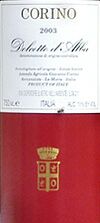|
This article was published in The 30 Second Wine Advisor on Wednesday, Sept. 21, 2005. Thoughts on vintage Before I grew up to become a wine "geek," I thought one of the most confusing things about wine appreciation was all that business about vintages. Good years, bad years, even mediocre years ... how can you keep all that information straight in your head, I used to wonder ... and does it really matter anyway? Now that I've been writing about wine for more than 20 years, I've found that there's no better way to learn vintages than simply letting nature take its course: Every year, trailing the calendar by a few months (Beaujolais Nouveau) to several years (Bordeaux, Chianti Classico Riserva), each new vintage comes through the pipeline, bringing its own surprises and teaching us its particular lessons through tasting. Live through a few vintages, learn them in your glass, and before long you realize that you do have a lot of that info in your head. (But there's still no harm in supplementing your memory by looking it up.) Now the 2003 vintage is working its way through the commercial wine-distribution system like an undigested meal passing through a python, and the idiosyncratic wines of this most peculiar summer offer a good opportunity to make a few points about vintage and its place in wine appreciation. Before I get to today's tasting report on a particularly fetching Northwestern Italian red that provides compelling testimony that 2003 was not entirely bad, let's tick off a few random "bullet points" about some ways that wine lovers use - and abuse - information about vintage. • Vintage, the year shown on the bottle of most fine wines, reflects the year in which the grapes were picked. This is important because wine grapes are an agricultural product, and weather conditions can have a significant effect on the wine, whether it's vine-killing winter freeze, bud-killing spring frost, summer storms and hail, or rains at harvest time. A year of perfect weather may yield exceptional wine, and there's something of a parable in that. The extreme heat of 2003 fostered very ripe fruit in much of Europe, a reality that's not necessarily a blessing, as over-ripe grapes tend to make fat, lower-acid wines more typical of the New World than Burgundy, the Loire or the Northern Rhone. • Weather is local. One region's terrible vintage may be decent in another and excellent in a third. Consider 1989, a lackluster year in Napa but very good in Bordeaux, compared with 1991, which was rather fine in Napa and absolutely terrible in Bordeaux. Indeed, when we talk about 2003's intense heat, it's important to specify that we're talking only about Europe. It was an excellent year in South Africa, and "difficult" in much of California and Down Under. • Vintage quality works only as a broad generalization. Some producers make excellent wines in "poor" vintages, and a few make stinkers in "can't miss" years. Moreover, the storm or frost that devastated vines in one village may have missed its neighbor. It's rare to have a vintage so poor that it's reasonable for consumers to write it off entirely. The 1991 vintage in Bordeaux comes close to this mark, and 2002 in the Southern Rhone. But now and then the wine contrarian can find value by cherry-picking better wines from vintages that the conventional wisdom says to avoid. • Trust your own taste buds more than vintage charts. Bear in mind that even wine professionals don't always agree. Robert M. Parker Jr. has highly rated many of the big, strong and ripe French 2003s, for example, an endorsement that's driving prices but also fostering controversy among those who don't share his affection for atypical French wines that taste like California or Australian blockbusters. That should be enough food for thought for today's meal. Stay tuned, I have a few more notes on surprising 2003s lined up for reporting soon.
Dark garnet, black at the center. Bold, forward black fruit, plums and tart cherries, on the nose and palate. Bone-dry, sharp acidity and chalky tannins; but over it all, juicy black plums, fresh, mouth-filling and tart. Vintner Select, Mason, Ohio, and other regional importers; from Marc de Grazia. (Sept. 12, 2005) FOOD MATCH: Well matched with a simple pasta dish of Italian sausage and rapini (broccoli rabe) over rigatoni. VALUE: Appropriate at this price point. WHEN TO DRINK: Dolcetto is the wine that the Piemontese drink while waiting for the long-lived Barolo and Barbaresco to come around. My experience with it generally suggests drinking it within two or three years of the vintage, although this big 2003 may last a little longer than most.
PRONUNCIATION:
WEB LINK:
FIND THIS WINE ONLINE:
|
 Giovanni Corino 2003 Dolcetto d'Alba ($15)
Giovanni Corino 2003 Dolcetto d'Alba ($15)